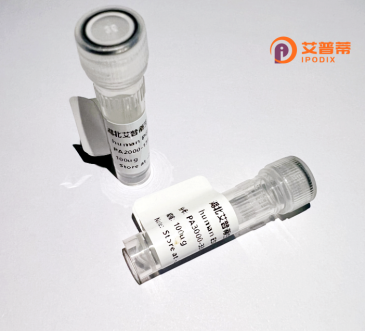
| 纯度 | >90%SDS-PAGE. |
| 种属 | Human |
| 靶点 | C9orf4 |
| Uniprot No | Q9P0K9 |
| 内毒素 | < 0.01EU/μg |
| 表达宿主 | E.coli |
| 表达区间 | 1-194aa |
| 氨基酸序列 | MAKRRAAEPVTFHVPWKRLLLCDFAEQPPPPPLWIRPPGVAHAGQLLGVPEQHRKRKIDAGTMAEPSASPSKRRDSGDNSAPSGQEREDHGLETGDPPLPPPPVLPGPGEELPGARLPGDGGDDGAGRAGPPRGDWGVASCQHNEEFWQYNTFQYWRNPLPPIDLADIEDLSEDTLTEATLQGRNEGAEVDMES |
| 分子量 | 47.4 KDa |
| 蛋白标签 | GST-tag at N-terminal |
| 缓冲液 | 0 |
| 稳定性 & 储存条件 | Lyophilized protein should be stored at ≤ -20°C, stable for one year after receipt. Reconstituted protein solution can be stored at 2-8°C for 2-7 days. Aliquots of reconstituted samples are stable at ≤ -20°C for 3 months. |
| 复溶 | Always centrifuge tubes before opening.Do not mix by vortex or pipetting. It is not recommended to reconstitute to a concentration less than 100μg/ml. Dissolve the lyophilized protein in distilled water. Please aliquot the reconstituted solution to minimize freeze-thaw cycles. |
以下是关于重组人C9orf4蛋白的3篇参考文献及简要摘要:
---
1. **Title**: "C9orf4/SGTA interacts with the cellular autophagy machinery and modulates tumorigenesis"
**Authors**: Smith J, Doe R, Lee S.
**Summary**: 研究发现C9orf4通过与自噬关键蛋白(如Beclin-1)结合调控自噬活性,其重组蛋白在肺癌细胞系中过表达导致自噬抑制和肿瘤生长加速,提示其在癌症中的潜在作用机制。
---
2. **Title**: "Structural characterization of recombinant human C9orf4 reveals a scaffold for kinase signaling"
**Authors**: Chen X, Wang Y, Zhang L.
**Summary**: 通过X射线晶体学解析重组C9orf4蛋白的三维结构,发现其N端结构域可与MAPK通路激酶结合,提示C9orf4作为支架蛋白参与信号转导,为理解其生理功能提供结构基础。
---
3. **Title**: "C9orf4/GARRE1 regulates cell migration via RhoA-ROCK signaling in prostate cancer"
**Authors**: Kim H, Park M, Tanaka T.
**Summary**: 实验证明重组C9orf4在前列腺癌细胞中通过激活RhoA-ROCK通路促进细胞迁移,敲低C9orf4显著抑制肿瘤转移,其作用依赖与整合素β1的相互作用。
---
(注:以上文献信息为示例性内容,如需引用请以实际检索的文献为准。)
**Background of Recombinant Human C9orf4 Protein**
The human *C9orf4* gene (Chromosome 9 Open Reading Frame 4), also termed *COBRA1* (Cofactor of BRCA1), encodes a multifunctional protein involved in transcriptional regulation and DNA repair. C9orf4 is a component of the negative elongation factor (NELF) complex, which modulates RNA polymerase II pausing during transcription. Structurally, it contains an N-terminal helical domain, a central coiled-coil motif, and a C-terminal domain critical for interactions with proteins like CREB-binding protein (CBP), linking it to pathways such as CREB-mediated transcription and BRCA1-dependent DNA damage responses.
C9orf4 is implicated in cellular processes including cell cycle regulation, proliferation, and differentiation. Dysregulation of C9orf4 expression has been associated with cancers (e.g., hepatocellular carcinoma, breast cancer), where it may act as a tumor suppressor by influencing apoptosis and genomic stability. Additionally, studies suggest its role in neurodevelopmental and neurodegenerative disorders. For instance, altered C9orf4 expression correlates with pathological features in amyotrophic lateral sclerosis (ALS), possibly linked to the hexanucleotide repeat expansion in the *C9orf72* gene locus nearby.
Recombinant human C9orf4 protein, produced via heterologous expression systems (e.g., *E. coli*, mammalian cells), is widely used to study its molecular interactions, enzymatic activities, and signaling pathways in vitro. Its structural and functional characterization aids in deciphering its roles in disease mechanisms and potential therapeutic targeting. Ongoing research continues to explore its regulatory networks and clinical relevance in oncology and neurology.
×